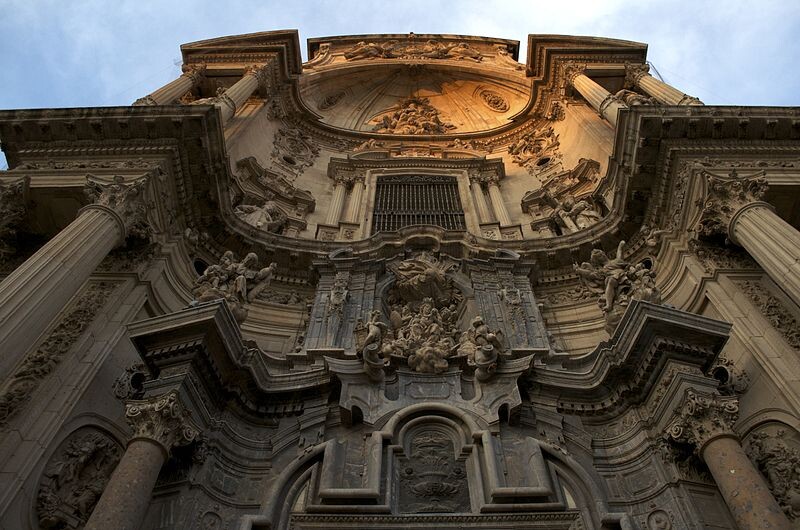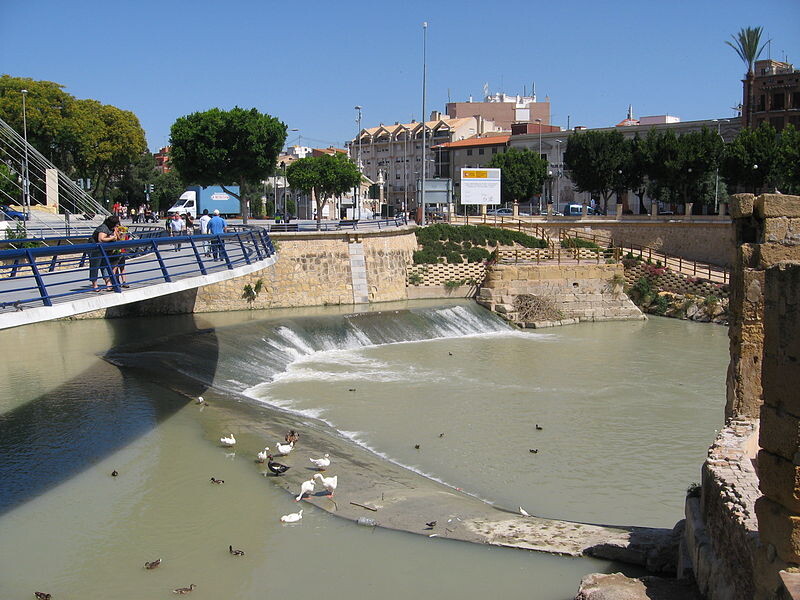Visiting Murcia in 2 days
- Tips and advice for living in or travelling around Murcia
- Managing your money in Murcia
- How to get to Murcia
- Neighbourhoods in Murcia
- Accommodation in Murcia
- Food and restaurants in Murcia
- Nights out in Murcia
- Transport in Murcia
- What to see and do in Murcia
- Trips and days out in Murcia
- Parties and festivals in Murcia
- What are you looking for in Murcia?
- Visiting Murcia for 2 days
Day 1
You've just arrived in Murcia and you don't know where to begin? Don't worry, if you follow this itinerary you will not only enjoy all the best bits of Murcia, but you will also do it in just 2 days. As it's a city with such a welcoming center, all of the most well-known places are really close to each other, so it will be easy to visit the city and see the most important sites in a record time of just two days.
In the morning

From this point onwards, you should know that the river which is dividing the city of Murcia, the Segura river, will be a good reference point to go back to when it comes to orienting yourself through the neighborhoods and streets there. Now that you know that, we will begin our itinerary with a walk through the Jardín del Malecón, depending on the time of year you are in, you may find different places or cabins, where you can try typical Murcian dishes.
Having already travelled to one of the green spaces within the city, you should go and see La Glorieta de España, where you can take a photo in front of the Murcia Town Hall. This building is a clear example of neoclassical architecture and, along with the flowers that cover La Glorieta, leaves you with the most charming memories. You can go inside and discover what it has to offer, without paying a single penny!
Once outside the Town Hall, head to Cardenal Belluga square and, right in front of you, you will find the Murcia Cathedral. This incredible monument is the brilliant result of a combination of four different types of architecture that have been developed throughout time: Gothic, Renaissance, Baroque and Neoclassical. Head in and soak up even the smallest of details! Its majestic domes and its stunning decoration make you feel as small as an ant, but the cathedral visit doesn't stop there. Head inside the museum, which costs only €3, and discover everything about our crown jewel. And to round off the visit, for just €5 you can go up the tower and take a look at the city of Murcia from some of the best viewpoints available.
When leaving the Cathedral, head towards Trapería. It's one of the busiest streets that runs through the old town from the Cathedral to the Plaza Santo Domingo. Halfway along, you will find the Real Casino de Murcia on the right hand side. This stop, just like the Cathedral, is practically obligatory. The Real Casino de Murcia is officially declared a site of Cultural Interest thanks to the great display of neo-Nazari elements in its architectural structure; its beauty and complexity will take your breath away.
When leaving, continue along calle Trapería until you arrive at the Plaza Santo Domingo and then head down to the Plaza de la Merced. If you fancy a beer and some chips mid-morning with views of the Facultad de Letras and the Jardín de la Fama, this is the square to go to for the best bars at the cheapest prices; we would suggest going to Maraña, La Playa or Íberos.
As you will already be hungry, go down Obispo Frutos street and, after having walked for about 3 minutes, you will find the famous Plaza de Toros de Murcia (Murcia Bullring). Going down any of the streets that are in front of the Plaza de Toros, will lead you to a tonne of bars where you can stuff yourself with tapas at a really good price, thanks to the "caña y tapa" (beer and tapas) offers. We can also recommend a few places that you will find off the beaten track when looking for places to eat, so that you know the best places to go for value for money: La Bernarda, Los Toneles, Los Zagales, El Rincón del Chapas, el Fraskito, La Tapadera o Las Pintas Murcianas.
In the afternoon
After eating a good meal, what you need next is dessert. For this, we recommend going to a café called Socolá, where they have some of the most amazing cakes and sweet treats, before we even mention the coffee there; they have thousands of different types of coffee and they are all super tasty.
After having a coffee and getting some energy back, set off again on your travels and return to Plaza Santo Domingo, but this time head in the direction of the university. In this occasion, we're going to the Teatro Romea, which is in Plaza Julián Romea. It's an eclectic theatre with neoclassical roots; the most famous theatre in the area and one of the most important on a national level.
If we then keep going towards Gran Via, the main street of excellence in the city-centre, you will see the immense amount of shops that are available there; both this street and Calle Platería are the best to go to for shopping. From there, on the right hand side towards the river, you will find the Plaza de Flores, a beautiful place which is filled with atmosphere, perfect to go and have a beer or two with friends and let yourself be carried away by the Murcian beer spirit. It is in the middle of the historical area, so you will see how the buildings and fountains elegantly blend in with the tasty looking tapas that the serve in the bars there. It's the perfect place to eat a bit of tapas before going back to sleep, because you will need to re-energise for the following day that awaits you.

Day 2
In the morning
Don't get up too late, because you need to set off to La Fuensanta!
Let's go one step at a time. To start with, what is La Fuensanta? Here you can see the experiences of other people who have also visited this sanctuary and have fallen in love with La Fuensanta as a place. It is the Santuario de Nuestra Señora de la Fuensanta, one of the most visited tourist and religious destinations in the Region of Murcia. You have to go and see it at least once in your lifetime, so pay attention to the different ways in which you can get there. The easiest way would be to travel by car, but if that's not an option for you, you can get there on foot, just like they do during the Romería, or by bus. If you decide to take the bus, you can either take the number 50 Latbus, which leaves you at the Sanctuary, or either of the 29 and number 6 buses, that leave you in the town from which you follow the path; as long as you follow all the signs, you can't get lost. It is completely free to visit the sanctuary and the visiting hours are Monday to Sunday between 9am and 1pm, and then again between 4pm and 6.30.
From there you will have on one side, the best views of the whole of Murcia, and then on the other side you will have the sanctuary of the patron saint of the City.
Now, you'll probably be hungry after all of this, so now is the time to replace all the energy that you've burned. Right inside the Fuensanta, you will find a bar called Quitapesares which has, without a doubt, one of the best views of all of Murcia. And, contrary to what you would think, considering the views and the location, it's not at all expensive, and if that's not enough, whatever you order is sure to be amazing. Bon apetit!

In the afternoon
In the afternoon, after your food has settled, it's time to head back into the city, but this time get off at the barrio del Carmen, because now we're going to explore the other side of the river.
Head to the Iglesia del Carmen (the church), which is found in the main street of this area, to see some of that baroque style decoration that is found on almost all of the monuments in the region. Both its exterior and its interior bring out these features, but the most remarkable thing is an element that is found on the inside, the Cristo de la Sangre (a statue of Jesus Christ on the cross).
When leaving, you will find one of the oldest gardens in the city, Jardín de Floridablanca, right in front of your eyes, which has been there for approximately 2 centuries. This garden is by far one of the most beautiful places in the whole city, and to tell the truth, it often goes unnoticed. Delve into these humble gardens and take a stroll along its paths, enjoying the fresh air that this green area of Murcia has to offer. It's always beautiful, no matter where you look. If you look up, you will see the centennial ficus that have been shading our fellow Murcian citizens for two centuries; and if you look down, you will see the great variety of botanical species that are planted and spread out across both sides of the path.
When you feel like continuing your tour, you just have to continue up the street towards the river and cross the Puente de los Peligros, also known as Puente Viejo; one of the most historical bridges in the city, where strangely enough, people always cross themselves when passing by to receive the blessing of the Virgen de los Peligros as a tradition. This tradition goes back centuries, to when the bridge was made of wood and Murcians felt immense fear when crossing it; the people were so terrified that they crossed themselves before crossing to entrust themselves to the virgin.
And what better way to end your tour of Murcia, than rounding it off by having dinner in a restaurant with views of the cathedral. But not in the Plaza del Cardenal Belluga, instead behind it, in La Cocina de Vives, where you will find traditional Spanish cuisine at the best price and with impeccable taste.

- Go back to What are you looking for in Murcia?
Photo gallery
Content available in other languages
- Español: Visita Murcia en 2 días
- Italiano: Visita Murcia in 2 giorni
- Français: Visite Murcie en deux jours
Want to have your own Erasmus blog?
If you are experiencing living abroad, you're an avid traveller or want to promote the city where you live... create your own blog and share your adventures!
I want to create my Erasmus blog! →



















Comments (0 comments)